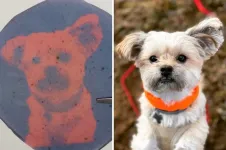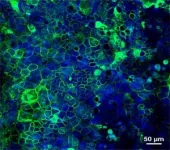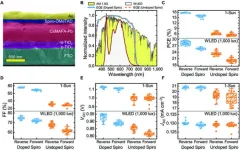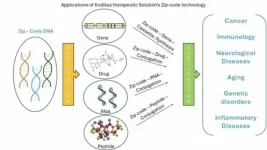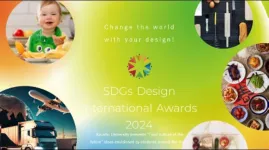(Press-News.org) Imagine if physicians could capture three-dimensional projections of medical scans, suspending them inside an acrylic cube to create a hand-held reproduction of a patient's heart, brain, kidneys, or other organs. Then, when the visit is done, a quick blast of heat erases the projection and the cube is ready for the next scan.
A new report in the journal Chem by researchers at Dartmouth and Southern Methodist University (SMU) outlines a technical breakthrough that could enable such scenarios, and others with widespread utility.
The study introduces a technique that uses a specialized light projector to imprint two-dimensional and 3D images inside any polymer that contains a photosensitive chemical additive the team developed. The light-based engraving remains in the polymer until heat is applied, which erases the image and makes it ready to use again.
In short, the researchers write with light and erase with heat or light, says Ivan Aprahamian, professor and chair of chemistry at Dartmouth and co-corresponding author on the paper. In test trials, the researchers produced high-resolution images in polymers ranging from thin films to six inches thick.
The technology is intended for any situation where having detailed, precise visual data in a compact and easily customizable format could be critical, Aprahamian says, such as planning surgeries and developing architectural designs. The device also could be used for generating 3D images for education and even creating art, he says.
"This is like 3D printing that is reversible," Aprahamian says. "You can take any polymer that has the optimal optic properties—that is, it's translucent—and enhance it with our chemical switch. Now that polymer is a 3D display. You do not need virtual reality headsets or complicated instrumentation. All you need is the right piece of plastic and our technology."
Readily available polymers—such as an acrylic cube—could be transformed into a display with the addition of the light-sensitive chemical "switch" formulated by Aprahamian and Qingkai Qi, a postdoctoral researcher at Dartmouth and the study's first author. The switch consists of a compound called azobenzene that reacts to light paired with boron difluoride, which enhances the switch's optical properties.
Once integrated with a polymer, the switch reacts to wavelengths of red and blue light beamed from a projector developed in the lab of Alex Lippert, professor of chemistry at SMU and co-corresponding author of the study. Study co-author Joshua Plank is a PhD candidate in Lippert's lab. The red light acts like ink by activating the chemical additive to create the image, Aprahamian says. Blue light can then be used to erase it.
The projector illuminates the treated polymer from different angles with various patterns of light, Lippert explains. The photosensitive chemical developed in Aprahamian's lab at Dartmouth is activated where these patterns intersect to produce 3D patterns. Creating 3D projections from 2D images such as a chest X-ray would mean projecting slices of the original image into a polymer cube or other shape until the slices combine to form the full 3D image, Lippert says.
The researchers have been able to produce animated images in polymers and future work revolves around improving that process. In the meantime, the technology reported in Chem could be developed for practical use in its current form, such as for industry or health care.
"Scaling up requires tuning the chemical switch properties to improve resolution, contrast, and refresh rate," Lippert says. "The projector system can in principle be scaled up and developed into a turnkey system with automated hardware and associated software for easy use."
###
END
New technology uses light to engrave erasable 3D images
Study: Chemical "switch" and projector make any polymer a reusable 3D canvas
2024-08-09
ELSE PRESS RELEASES FROM THIS DATE:
How did mental health parity laws affect new moms?
2024-08-09
Pregnant and postpartum women with depression and anxiety have a slightly better chance of getting psychotherapy these days, a new study finds. And they are paying less of their own money when they do.
The changes in care and cost happened mainly after the Affordable Care Act took effect in 2014, and to a lesser extent after the Mental Health Parity and Addiction Equity Act, or MHPAEA, took effect in 2010, the analysis shows.
Both laws aimed at reducing insurance-related barriers to mental health care.
Even so, only about 10% of women with private insurance ...
Universal free school meals and school and student outcomes
2024-08-09
About The Study: In this systematic review, universal free school meals were associated with increased meal participation, no or slight improvements in attendance, and decreased obesity prevalence and suspension rates; certainty of evidence was moderate for lunch participation and low or very low for other outcomes. Studies did not report several important outcomes, such as diet quality and food security, suggesting the need for more high-quality research encompassing policy-relevant indicators.
Corresponding Author: To ...
Researchers crack a key celiac mystery
2024-08-09
People with celiac disease must navigate everyday life by avoiding gluten, a protein in wheat, rye and barley which can trigger painful symptoms in the gut, impede the absorption of nutrients and raise the risk of other serious long-term issues.
The autoimmune disorder affects about 1 per cent of the population. Its rate of occurrence has roughly doubled in the past 25 years, but there is no treatment available.
An interdisciplinary team of medical and engineering researchers centred at Canada’s McMaster University and including colleagues from the US, Australia, and Argentina, has spent the ...
Continuing climate warming trend and pronounced interannual variability in precipitation in the Three Gorges Region in 2022–2023
2024-08-09
The Three Gorges Region of the Yangtze River (TGR) in China has a unique geographical location, complex geomorphological features, and a fragile and sensitive climate. The Three Gorges Project, as a large-scale comprehensive water conservancy hub project in the region, has not only greatly changed the nature, society and economy of the area, but also brought great benefits and created problems, such as environmental and climatic impacts. Therefore, it is of great importance to conduct climate and environmental monitoring in the region.
Recently, a team led by Chen Xianyan, a Professor at ...
Is doping of Spiro-OMeTAD a requirement for efficient and stable perovskite indoor photovoltaics?
2024-08-09
In this work, we study the outdoor and indoor photovoltaic performance of LHP-based devices utilizing Spiro-OMeTAD as the hole-transport material with commonly used dopants such as lithium bis(trifluoromethanesulfonyl)imide (Li-TFSI) or without any dopants. We find out that, despite the expected low performance of devices employing undoped Spiro-OMeTAD layer under 1-Sun illumination (up to 7.7% efficiency), the devices achieve up to 25.6% efficiency under 1000 lux illumination, which is comparable to the doped counterpart devices achieving up to 29.7% efficiency. This is mainly due to the major improvement in fill factor when going towards low-light ...
HKUST engineering researchers enhance perovskite solar cells durability with first-of-its-kind chiral-structured “springy” interface
2024-08-09
A research team led by the School of Engineering of the Hong Kong University of Science and Technology (HKUST) has constructed an unprecedented chiral-structured interface in perovskite solar cells, which enhances the reliability and power conversion efficiency of this fast-advancing solar technology and accelerates its commercialization.
A perovskite solar cell (PSC) is a type of solar cell that includes perovskite-structured compound materials, which are inexpensive to produce and simple to manufacture. Unlike conventional silicon solar cells that require expensive high-temperature, high-vacuum fabrication processes, perovskites can ...
GSA announces 2024 Award Winners honoring excellence in geoscience
2024-08-09
Boulder, Colo., USA: The Geological Society of America (GSA) is proud to announce the recipients of the 2024 GSA Awards, recognizing outstanding contributions to the geoscience community. Each awardee has demonstrated exceptional dedication, innovation, and impact in their respective fields.
GSA President’s Medal
Kathy Jefferson Bancroftis, a Paiute-Shoshone community leader and environmental protector, is honored for her advocacy and education on water misuse and environmental degradation in the Owens Valley, ...
Retrotransposon DNA zip code for myeloma cell internalization
2024-08-09
“GT is a fascinating evolutionary phenomenon observed in lower species and humans, albeit with differing impacts and mechanisms.”
BUFFALO, NY- August 9, 2024 – A new editorial was published in Oncoscience (Volume 11) on July 13, 2024, entitled, “Unveiling retrotransposon-derived DNA zip code for myeloma cell internalization.”
The complex interplay between extracellular genetic material and the tumor's genetic landscape presents a significant challenge in grasping cancer evolution, tumor genetic heterogeneity, and treatment response. Earlier research has revealed the role of circulating tumor DNA (ctDNA) in mediating the gene expression among ...
High heat dissipation design improves thermal protection on ultrahigh temperature ablation
2024-08-09
ZrC has drawn wide attention as an anti-ablation coating material for lightweight C/C composites but is limited by the produced porous and loose ZrO2 film. To address this issue, the second phase is introduced to improve the densification of the formed Zr-X-O film. Such as ZrC-SiC/TaC coating, the produced low-melting-point oxides, SiO2 (Tm=1650 °C), Ta2O5 (Tm=1800 °C) and Zr6Ta2O17 (Tm=1900 °C), helped to form a dense oxides film. However, the high service temperature causes heat accumulation and a large thermal stress gradient on the surface of the coatings, which will result in large local defects and accelerate the failure of the coating. To decrease the ablation heat ...
SDGs Design International Awards 2024: Let’s create sustainable design for FOOD!
2024-08-09
Fukuoka, Japan—The SDGs Design International Awards 2024 are calling for students worldwide to submit their original ideas for using design to achieve Sustainable Development Goals.
First organized in 2019 and led by Faculty of Design, Kyushu University, the awards aim to demonstrate the power of design in solving social problems and to elevate society's expectations for design.
Now in its sixth year, this year’s theme is “Let’s Create Sustainable Design for FOOD." ...
LAST 30 PRESS RELEASES:
Why nail-biting, procrastination and other self-sabotaging behaviors are rooted in survival instincts
Regional variations in mechanical properties of porcine leptomeninges
Artificial empathy in therapy and healthcare: advancements in interpersonal interaction technologies
Why some brains switch gears more efficiently than others
UVA’s Jundong Li wins ICDM’S 2025 Tao Li Award for data mining, machine learning
UVA’s low-power, high-performance computer power player Mircea Stan earns National Academy of Inventors fellowship
Not playing by the rules: USU researcher explores filamentous algae dynamics in rivers
Do our body clocks influence our risk of dementia?
Anthropologists offer new evidence of bipedalism in long-debated fossil discovery
Safer receipt paper from wood
Dosage-sensitive genes suggest no whole-genome duplications in ancestral angiosperm
First ancient human herpesvirus genomes document their deep history with humans
Why Some Bacteria Survive Antibiotics and How to Stop Them - New study reveals that bacteria can survive antibiotic treatment through two fundamentally different “shutdown modes”
UCLA study links scar healing to dangerous placenta condition
CHANGE-seq-BE finds off-target changes in the genome from base editors
The Journal of Nuclear Medicine Ahead-of-Print Tip Sheet: January 2, 2026
Delayed or absent first dose of measles, mumps, and rubella vaccination
Trends in US preterm birth rates by household income and race and ethnicity
Study identifies potential biomarker linked to progression and brain inflammation in multiple sclerosis
Many mothers in Norway do not show up for postnatal check-ups
Researchers want to find out why quick clay is so unstable
Superradiant spins show teamwork at the quantum scale
Cleveland Clinic Research links tumor bacteria to immunotherapy resistance in head and neck cancer
First Editorial of 2026: Resisting AI slop
Joint ground- and space-based observations reveal Saturn-mass rogue planet
Inheritable genetic variant offers protection against blood cancer risk and progression
Pigs settled Pacific islands alongside early human voyagers
A Coral reef’s daily pulse reshapes microbes in surrounding waters
EAST Tokamak experiments exceed plasma density limit, offering new approach to fusion ignition
Groundbreaking discovery reveals Africa’s oldest cremation pyre and complex ritual practices
[Press-News.org] New technology uses light to engrave erasable 3D imagesStudy: Chemical "switch" and projector make any polymer a reusable 3D canvas
